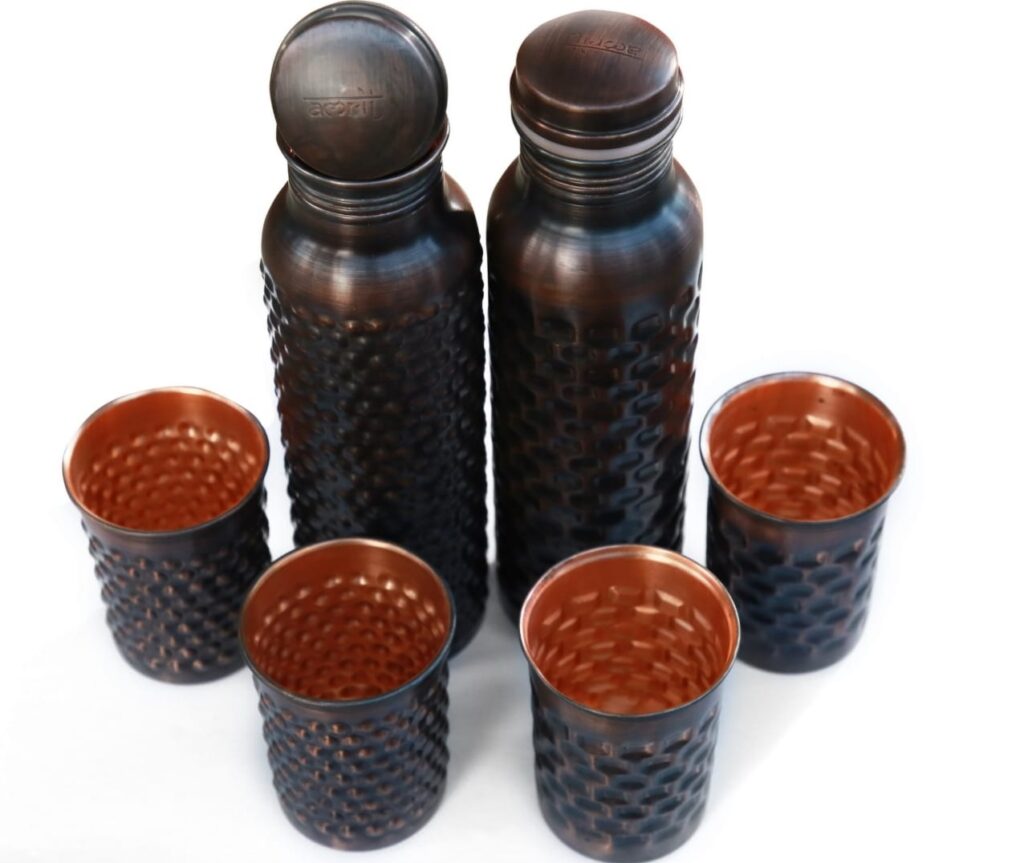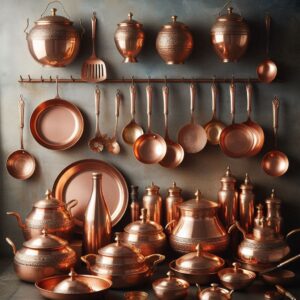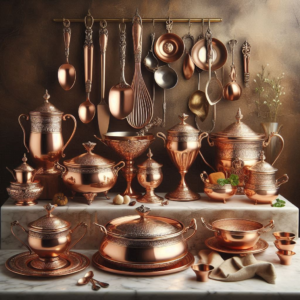Copper-insulated water bottles have gained popularity for their aesthetic appeal and the health benefits attributed to copper. Traditionally, copper has been valued in Ayurvedic practices for its potential to improve immune function, aid digestion, and promote wound healing. The metal is also known for its antibacterial properties, which can help keep water free from bacteria.
Despite these claims, there are concerns regarding the safety of using copper vessels for water storage. The primary issue is the possibility of copper leaching into the water, especially if the water is stored for extended periods or the bottle is not cleaned properly.
Excessive intake of copper can lead to toxicity, with symptoms like stomach aches, diarrhea, and vomiting. Therefore, it’s recommended to limit the use of copper vessels to two to three times a day and not to store water in them for more than three to six hours.
Moreover, while copper deficiency is rare, it’s important to note that most people get sufficient copper from their diet, and the additional intake from a copper water bottle is generally unnecessary. In fact, experts suggest that the health benefits marketed by copper water bottle companies are often overstated and lack scientific backing. The consensus among scientists is that, while copper is an essential nutrient, the contribution of copper bottles to one’s health is negligible.
Would you like more detailed information on this topic or guidance on how to properly use and maintain a copper water bottle?
The Allure of Copper: Historical and Modern Perspectives
Copper-insulated water bottles has been utilized for water storage since ancient times, with its use dating back to civilizations such as the Indus Valley around 4500 BCE. The antimicrobial properties of copper were recognized early on, and it was used to purify water, a practice that was especially important in areas without modern water purification systems. In Ayurveda, copper vessels were recommended for storing water, and even the ancient Egyptians used copper to keep water fresh.
The modern resurgence of copper water bottles can be attributed to a renewed interest in Ayurvedic practices and the aesthetic appeal of copper as a material. People are drawn to the traditional look and the belief in health benefits such as improved immune function, digestion, and wound healing, which are associated with copper’s antibacterial properties.
However, it’s important to note that while copper does have health benefits, these claims are often overstated. The actual contribution of copper water bottles to one’s health is minimal, as most people get sufficient copper from their diet. Moreover, there are safety considerations to keep in mind, such as avoiding the storage of water in copper vessels for extended periods to prevent copper leaching.
The allure of copper water bottles lies in their historical significance, aesthetic value, and perceived health benefits. While they can be safe when used correctly, it’s essential to be aware of the potential risks and to follow proper usage guidelines. Would you like to know more about how to use copper water bottles safely, or are you interested in another aspect of this topic?
Understanding Copper: Essential Mineral or Potential Hazard
Copper-insulated water bottles is an essential trace mineral that plays a pivotal role in various bodily functions. It’s involved in the production of red blood cells, the maintenance of nerve cells and the immune system, and it aids in the formation of collagen. Copper also helps the body absorb iron and contributes to energy production. Most of the copper in the body is found in the liver, brain, heart, kidneys, and skeletal muscle.
While copper deficiency is rare, it can lead to cardiovascular disease and other health issues. On the other hand, copper toxicity can occur if the body accumulates too much copper, either through genetic conditions or excessive exposure to copper in food, water, or environmental sources. Symptoms of copper toxicity can range from headaches and fever to more severe effects like liver damage, kidney failure, heart failure, and brain damage. In extreme cases, it can be fatal.
To prevent copper toxicity, it’s important to ensure that copper intake is balanced. The recommended dietary allowance for adults is 900 micrograms per day, and it’s generally advised not to exceed 10 milligrams per day to avoid adverse health effects. Copper levels in the body can be regulated through diet alone, and supplementation is usually not necessary unless prescribed by a healthcare professional
The Science of Safety: How Copper Interacts with Water
Copper’s interaction with water is a subject of considerable scientific interest, particularly in the context of its use in water storage and plumbing systems. At the molecular level, copper can react with water under certain conditions, leading to the leaching of copper ions into the water. This process is influenced by factors such as the water’s pH, temperature, and the presence of other chemicals that can corrode copper or facilitate its dissolution.

The conditions under which copper might leach into water include:
- Acidic Water: Water with a low pH is more corrosive to copper, which can cause more copper ions to leach into the water.
- High Temperatures: Elevated temperatures can accelerate the corrosion process, increasing the rate at which copper leaches into the water.
- Stagnant Water: Water that remains in contact with copper pipes or vessels for extended periods is more likely to absorb copper ions.
- Oxygenated Water: The presence of oxygen can enhance the corrosion of copper, especially in hot water systems.
Comparing Bottle Materials: Copper vs. Alternatives
When comparing water bottles made from different materials, each has its unique advantages and disadvantages, especially from a safety perspective:
Copper:
- Pros: Copper bottles have natural antibacterial properties and can offer health benefits when used properly. They are also eco-friendly and durable.
- Cons: Copper can leach into water, especially when acidic or hot, leading to potential copper toxicity if consumed in large amounts. They require regular maintenance to prevent this.
Stainless Steel:
- Pros: Stainless steel bottles are durable, corrosion-resistant, and do not leach chemicals when exposed to heat. They are also good at maintaining temperature and are generally safe for storing beverages.
- Cons: They can be more expensive and may dent if dropped. Some people may dislike the metallic taste that can sometimes be imparted to the water.
Plastic:
- Pros: Plastic bottles are lightweight, inexpensive, and shatter-resistant, making them convenient for everyday use and travel.
- Cons: Many plastic bottles contain BPA or other chemicals that can leach into water, especially when heated or scratched. They are also less durable and environmentally friendly compared to metal bottles.
Glass:
- Pros: Glass bottles do not leach chemicals and can offer a pure taste. They are also recyclable and environmentally friendly.
- Cons: Glass is fragile and can break easily, which poses a safety risk. They are also typically heavier and less convenient for on-the-go use.
Real-World Use: Are Copper Water Bottles Safe for Daily Use?
Copper water bottles are generally considered safe for daily use when following certain best practices. Studies and user experiences suggest that the antibacterial properties of copper can be beneficial, but there is a risk of copper leaching into the water if the bottle is not used correctly.
Insights from Studies and User Experiences:
- Copper water has been shown to have antibacterial effects, which may be beneficial for people without access to safe drinking water.
- Some users have reported adverse reactions, such as stomach aches, when drinking water stored in copper bottles, especially if the water is stored for too long or the bottle is not cleaned properly.
Best Practices for Safety:
- Limit Usage: Do not drink water stored in a copper bottle all day long to avoid the risk of copper toxicity. It’s recommended to use the copper bottle two to three times a day and not store water in it for more than six hours.
- Avoid Acidic Contents: Do not store lemon, honey water, or other acidic beverages in copper bottles, as the acid can react with copper and increase the risk of leaching.
- Regular Cleaning: Clean the copper bottle regularly with a natural acid like lemon juice and salt to prevent oxidation and remove any patina that may form. This should be done every few weeks to maintain the effectiveness of the bottle.
Conclusion
In conclusion, copper-insulated water bottles carry both historical significance and modern appeal due to their aesthetic qualities and perceived health benefits. Historically, copper has been used for water storage due to its antimicrobial properties, and this practice has seen a resurgence with a growing interest in holistic health practices.
Copper is an essential trace mineral necessary for health, but it must be consumed in moderation to avoid toxicity.
The safety of copper bottle largely depends on proper usage and maintenance. It’s recommended not to store water in them for more than six hours to prevent copper leaching.
Regular cleaning of the bottle is crucial to prevent the accumulation of bacteria and potential copper toxicity.
Balanced View on Safety for Consumers: Copper water bottles can be a safe choice for consumers when used correctly. They offer the benefits of durability and antibacterial properties. However, consumers should be aware of the potential risks associated with improper use, such as copper leaching, and adhere to the recommended guidelines for cleaning and usage. It’s also important to note that while copper contributes to health, the additional intake from a copper water bottle is generally unnecessary for those with a balanced diet.











